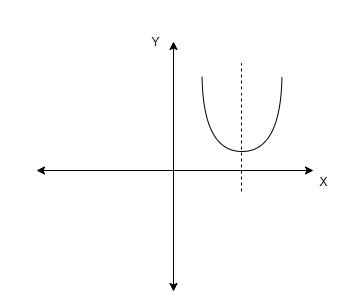
Find the equation of the parabola whose axis is parallel to $y-$axis and which passes through the points \[\left( 0,2 \right),\left( -1,0 \right)\] and \[\left( 1,6 \right)\].
Answer
606k+ views
Hint: The general form of the parabola \[y=a{{x}^{2}}+bx+c\] is to be used while solving this question.
Complete step-by-step answer:
In the question, it is given that the axis of the parabola is parallel to the $y-$axis. So, the parabola would look like the figure below.

We know that the general formula for this form of parabola is given by,
\[y=a{{x}^{2}}+bx+c\ldots \ldots \ldots \left( i \right)\]
It is given in the question that the parabola passes through the points \[\left( 0,2 \right),\left( -1,0 \right)\] and \[\left( 1,6 \right)\]. Since the parabola passes through the three points, we know that these points must satisfy the equation of the parabola. So, we can substitute each point in the equation $\left( i \right)$ and formulate three sets of equations.
Considering the first point \[\left( 0,2 \right)\] and substituting the values of \[x=0,y=2\] in equation $\left( i \right)$, we get
\[\begin{align}
& 2=a\times 0+b\times 0+c \\
& c=2\ldots \ldots \ldots \left( ii \right) \\
\end{align}\]
Considering the second point \[\left( -1,0 \right)\] and substituting the values of \[x=-1,y=0\] in equation $\left( i \right)$, we get
\[\begin{align}
& 0=a\times {{\left( -1 \right)}^{2}}+b\times -1+c \\
& 0=a-b+c \\
\end{align}\]
Now substituting the value of \[c\] from equation $\left( ii \right)$ in the above equation, we get
\[\begin{align}
& 0=a-b+2 \\
& b-a=2\ldots \ldots \ldots \left( iii \right) \\
\end{align}\]
Considering the last point \[\left( 1,6 \right)\] and substituting the values of \[x=1,y=6\] in equation $\left( i \right)$, we get
$\begin{align}
& 6=a\times {{1}^{2}}+b\times 1+c \\
& 6=a+b+c \\
\end{align}$
Now substituting the value of \[c\] from equation $\left( ii \right)$ in the above equation, we get
\[\begin{align}
& 6=a+b+2 \\
& a+b=4\ldots \ldots \ldots \left( iv \right) \\
\end{align}\]
We have two equations \[\left( iii \right)\] and $\left( iv \right)$ to get the values of the \[a\] and $b$. So, adding the equations,
\[\dfrac{\begin{align}
& b-a=2 \\
& a+b=4 \\
\end{align}}{\begin{align}
& 2b=6 \\
& b=3 \\
\end{align}}\]
Substituting \[b=3\] in equation \[\left( iii \right)\], we get
\[\begin{align}
& 3-a=2 \\
& a=1 \\
\end{align}\]
Now we have the values as $a=1,b=3,c=2$. So, we can substitute this in equation $\left( i \right)$,
\[y={{x}^{2}}+3x+2\]
Therefore, the required equation of the parabola is obtained as \[y={{x}^{2}}+3x+2\].
Note: As three points are given in the question, we can formulate three equations and easily compute the three unknowns in the equation. If you are familiar with the cross-multiplication method, you can solve the equations and get the values of \[a,b,c\] in less time.
Complete step-by-step answer:
In the question, it is given that the axis of the parabola is parallel to the $y-$axis. So, the parabola would look like the figure below.

We know that the general formula for this form of parabola is given by,
\[y=a{{x}^{2}}+bx+c\ldots \ldots \ldots \left( i \right)\]
It is given in the question that the parabola passes through the points \[\left( 0,2 \right),\left( -1,0 \right)\] and \[\left( 1,6 \right)\]. Since the parabola passes through the three points, we know that these points must satisfy the equation of the parabola. So, we can substitute each point in the equation $\left( i \right)$ and formulate three sets of equations.
Considering the first point \[\left( 0,2 \right)\] and substituting the values of \[x=0,y=2\] in equation $\left( i \right)$, we get
\[\begin{align}
& 2=a\times 0+b\times 0+c \\
& c=2\ldots \ldots \ldots \left( ii \right) \\
\end{align}\]
Considering the second point \[\left( -1,0 \right)\] and substituting the values of \[x=-1,y=0\] in equation $\left( i \right)$, we get
\[\begin{align}
& 0=a\times {{\left( -1 \right)}^{2}}+b\times -1+c \\
& 0=a-b+c \\
\end{align}\]
Now substituting the value of \[c\] from equation $\left( ii \right)$ in the above equation, we get
\[\begin{align}
& 0=a-b+2 \\
& b-a=2\ldots \ldots \ldots \left( iii \right) \\
\end{align}\]
Considering the last point \[\left( 1,6 \right)\] and substituting the values of \[x=1,y=6\] in equation $\left( i \right)$, we get
$\begin{align}
& 6=a\times {{1}^{2}}+b\times 1+c \\
& 6=a+b+c \\
\end{align}$
Now substituting the value of \[c\] from equation $\left( ii \right)$ in the above equation, we get
\[\begin{align}
& 6=a+b+2 \\
& a+b=4\ldots \ldots \ldots \left( iv \right) \\
\end{align}\]
We have two equations \[\left( iii \right)\] and $\left( iv \right)$ to get the values of the \[a\] and $b$. So, adding the equations,
\[\dfrac{\begin{align}
& b-a=2 \\
& a+b=4 \\
\end{align}}{\begin{align}
& 2b=6 \\
& b=3 \\
\end{align}}\]
Substituting \[b=3\] in equation \[\left( iii \right)\], we get
\[\begin{align}
& 3-a=2 \\
& a=1 \\
\end{align}\]
Now we have the values as $a=1,b=3,c=2$. So, we can substitute this in equation $\left( i \right)$,
\[y={{x}^{2}}+3x+2\]
Therefore, the required equation of the parabola is obtained as \[y={{x}^{2}}+3x+2\].
Note: As three points are given in the question, we can formulate three equations and easily compute the three unknowns in the equation. If you are familiar with the cross-multiplication method, you can solve the equations and get the values of \[a,b,c\] in less time.
Recently Updated Pages
Master Class 11 Business Studies: Engaging Questions & Answers for Success

Master Class 11 Computer Science: Engaging Questions & Answers for Success

Master Class 11 Maths: Engaging Questions & Answers for Success

Master Class 11 Chemistry: Engaging Questions & Answers for Success

Master Class 11 Economics: Engaging Questions & Answers for Success

Master Class 11 Accountancy: Engaging Questions & Answers for Success

Trending doubts
What is meant by exothermic and endothermic reactions class 11 chemistry CBSE

10 examples of friction in our daily life

One Metric ton is equal to kg A 10000 B 1000 C 100 class 11 physics CBSE

1 Quintal is equal to a 110 kg b 10 kg c 100kg d 1000 class 11 physics CBSE

Difference Between Prokaryotic Cells and Eukaryotic Cells

What are Quantum numbers Explain the quantum number class 11 chemistry CBSE




